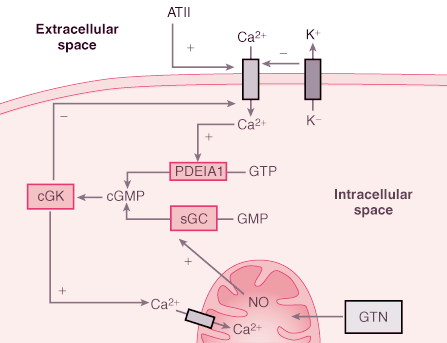 |
 |
Figure 50-10
Mechanisms of action of glyceryl trinitrate (GTN). GTN
is metabolized to NO, which stimulates the synthesis of cyclic guanosine monophosphate
(cGMP). In turn, cGMP reduces cytoplasmic Ca2+
by inhibiting inflow and
stimulating mitochondrial uptake, which causes relaxation of smooth muscle cells.
The role of Ca2+
-activated K+
currents is also being investigated;
by inducing hyperpolarization of the cellular membrane, they might contribute to
the limitation of Ca2+
entry into smooth muscle cells, and in endothelial
cells, they might inhibit •
O2
-
production.
By promoting Ca2+
uptake, antithrombin II (AT II) can increase cytoplasmic
Ca2+
and induce Ca2+
-dependent phosphodiesterase 1A1 (PDE1A1).
This may lead to reduced cGMP and cGK activity, thus providing an elegant explanation
for both nitrate tolerance and increased sensitivity to AT III. Some evidence supports
a redox sensitivity of all enzymes involved in these procedures. GTP, guanosine
triphosphate; sGC, soluble guanylyl cyclase; cGK, cGMP-dependent protein kinase.
(Redrawn from Gori T, Parker JD: Nitrate tolerance. A unifying hypothesis.
Circulation 106:2510–2513, 2002.)

 |
